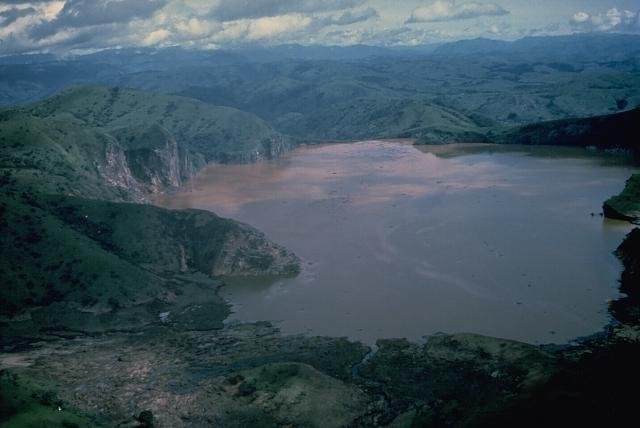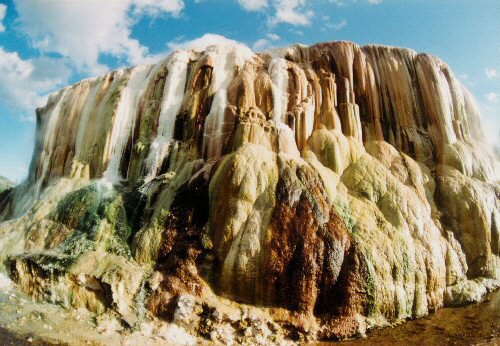|
Alligator Lake (Philippines)
Tadlac Lake, also colloquially known as Crocodile Lake, is a freshwater Maar, volcanic maar lake located in Barangay Tadlac, in the Municipalities of the Philippines, municipality of Los Baños, Laguna, Los Baños, Laguna (province), Laguna. The lake-filled maar is located along the southern shore of Laguna de Bay, the largest lake in the Philippines, with Tadlac Lake protruding out of the shore of the larger lake. If not for its slightly-elevated crater rim, Tadlac Lake would be wholly engulfed by Laguna de Bay. The volcanic lake is one of many maars in the Laguna Volcanic Field. It is listed as one of the List of inactive volcanoes in the Philippines, inactive volcanos in the Philippines by the Philippine Institute of Volcanology and Seismology (PHIVOLCS). Tadlac Lake is also notable for its history of annual lake overturns, locally called ''langal.'' This phenomenon, rare elsewhere but common in Tadlac Lake during the cold season (December-February), is the result of trapped c ... [...More Info...] [...Related Items...] OR: [Wikipedia] [Google] [Baidu] |
Los Baños, Laguna
Los Baños (IPA: Help:IPA/Tagalog, [lɔs bɐˈɲɔs]), officially the Municipality of Los Baños (), colloquially 'elbi' or simply LB, is a municipality of the Philippines, municipality in the Philippine Province, province of Laguna (province), Laguna, Philippines. According to the 2020 census, it has a population of 115,353 people. It has a total land area of and is bordered on the south and south-west by Mount Makiling and Santo Tomas, Batangas, Santo Tomas in Batangas, on the north by Laguna de Bay, on the north-west by Calamba, Laguna, Calamba and on the east by the town of Bay, Laguna, Bay. The town is located southeast of Manila and is easily accessible via the South Luzon Expressway along with Manila South Road and Calamba–Pagsanjan Road. The municipality lies on the northern slopes of the long dormant volcano Mount Makiling and is known among tourists for its hot spring resorts. Los Baños also hosts two constituent universities of the University of the Philippine ... [...More Info...] [...Related Items...] OR: [Wikipedia] [Google] [Baidu] |
Oxygen Saturation
Oxygen saturation (symbol SO2) is a relative measure of the concentration of oxygen that is Dissolution (chemistry), dissolved or carried in a given medium as a proportion of the maximal concentration that can be dissolved in that medium at the given temperature. It can be measured with a dissolved oxygen probe such as an oxygen sensor or an optode in liquid media, usually water. The standard unit of oxygen saturation is percent (%). Oxygen saturation can be measured regionally and noninvasively. Artery, Arterial oxygen saturation (SaO2) is commonly measured using pulse oximetry. Tissue saturation at peripheral scale can be measured using near-infrared spectroscopy, NIRS. This technique can be applied on both muscle and brain. In medicine In medicine, oxygen saturation refers to ''oxygenation'', or when oxygen molecules () enter the Tissue (biology), tissues of the body. In this case blood is oxygenated in the lungs, where oxygen molecules travel from the air into the blood. O ... [...More Info...] [...Related Items...] OR: [Wikipedia] [Google] [Baidu] |
History Of The Philippines (1521-1898)
The history of the Philippines dates from the earliest hominin activity in the archipelago at least by 709,000 years ago. '' Homo luzonensis'', a species of archaic humans, was present on the island of Luzon at least by 134,000 years ago. The earliest known anatomically modern human was from Tabon Caves in Palawan dating about 47,000 years. Negrito groups were the first inhabitants to settle in the prehistoric Philippines. These were followed by Austroasiatics, Papuans, and South Asians. By around 3000 BCE, seafaring Austronesians, who form the majority of the current population, migrated southward from Taiwan. By 2000 BCE the archipelago was the crux of a trans-oceanic Philippine jade culture. Scholars generally believe that these ethnic and social groups eventually developed into various settlements or polities with varying degrees of economic specialization, social stratification, and political organization. Some of these settlements (mostly those located on major rive ... [...More Info...] [...Related Items...] OR: [Wikipedia] [Google] [Baidu] |
Indigenous (ecology)
In biogeography, a native species is indigenous to a given region or ecosystem if its presence in that region is the result of only local natural evolution (though often popularised as "with no human intervention") during history. The term is equivalent to the concept of indigenous or autochthonous species. A wild organism (as opposed to a domesticated organism) is known as an introduced species within the regions where it was anthropogenically introduced. If an introduced species causes substantial ecological, environmental, and/or economic damage, it may be regarded more specifically as an invasive species. A native species in a location is not necessarily also endemic to that location. Endemic species are ''exclusively'' found in a particular place. A native species may occur in areas other than the one under consideration. The terms endemic and native also do not imply that an organism necessarily first originated or evolved where it is currently found. Notion The notio ... [...More Info...] [...Related Items...] OR: [Wikipedia] [Google] [Baidu] |
Lake Overturn
A limnic eruption, also known as a lake overturn, is a very rare type of natural hazard in which dissolved carbon dioxide () suddenly erupts from deep lake waters, forming a gas cloud capable of asphyxiating wildlife, livestock, and humans. Scientists believe earthquakes, volcanic activity, and other explosive events can serve as triggers for limnic eruptions as the rising ejects water from the lake. Lakes in which such activity occurs are referred to as limnically active lakes or exploding lakes. Some features of limnically active lakes include: * -saturated incoming water * A cool lake bottom indicating an absence of direct volcanic heat with lake waters * An upper and lower thermal layer with differing saturations * Proximity to areas with volcanic activity Investigations of the Lake Monoun and Lake Nyos casualties led scientists to classify limnic eruptions as a distinct type of hazard event, even though they can be indirectly linked to volcanic eruptions. [...More Info...] [...Related Items...] OR: [Wikipedia] [Google] [Baidu] |
Ovoid
An oval () is a closed curve in a plane which resembles the outline of an egg. The term is not very specific, but in some areas of mathematics (projective geometry, technical drawing, etc.), it is given a more precise definition, which may include either one or two axes of symmetry of an ellipse. In common English, the term is used in a broader sense: any shape which reminds one of an egg. The three-dimensional version of an oval is called an ovoid. Oval in geometry The term oval when used to describe curves in geometry is not well-defined, except in the context of projective geometry. Many distinct curves are commonly called ovals or are said to have an "oval shape". Generally, to be called an oval, a plane curve should ''resemble'' the outline of an egg or an ellipse. In particular, these are common traits of ovals: * they are differentiable (smooth-looking), simple (not self-intersecting), convex, closed, plane curves; * their shape does not depart much from that of ... [...More Info...] [...Related Items...] OR: [Wikipedia] [Google] [Baidu] |
Mount Makiling
Mount Makiling (also spelled Maquiling) is an inactive stratovolcano located in the provinces of Laguna and Batangas on the island of Luzon in the Philippines. The mountain rises to an elevation of above mean sea level and is the highest feature of the Laguna Volcanic Field. The volcano has no recorded historic eruption but volcanism is still evident through geothermal features like mud spring and hot springs. South of the mountain is the Makiling–Banahaw Geothermal Plant. The Philippine Institute of Volcanology and Seismology (PHIVOLCS) classifies the volcano as " Inactive". Mount Makiling is a state-owned forest reserve administered by the University of the Philippines Los Baños. Prior to its transfer to the university, the mountain was the first national park of the Philippines. Mount Makiling National Park was established on February 23, 1933, by Proclamation No. 552. However, it was decommissioned as a national park on June 20, 1963, by Republic Act No. 3523 when i ... [...More Info...] [...Related Items...] OR: [Wikipedia] [Google] [Baidu] |
Headland
A headland, also known as a head, is a coastal landform, a point of land usually high and often with a sheer drop, that extends into a body of water. It is a type of promontory. A headland of considerable size often is called a cape.Whittow, John (1984). ''Dictionary of Physical Geography''. London: Penguin, 1984, pp. 80, 246. . Headlands are characterised by high, breaking waves, rocky shores, intense erosion, and steep sea cliff. Headlands and bays are often found on the same coastline. A bay is flanked by land on three sides, whereas a headland is flanked by water on three sides. Headlands and bays form on discordant coastlines, where bands of rock of alternating resistance run perpendicular to the coast. Bays form when weak (less resistant) rocks (such as sands and clays) are eroded, leaving bands of stronger (more resistant) rocks (such as chalk, limestone, and granite) forming a headland, or peninsula. Through the deposition of sediment within the bay and the erosio ... [...More Info...] [...Related Items...] OR: [Wikipedia] [Google] [Baidu] |
Laguna Province
Laguna , officially the Province of Laguna (), is a province in the Philippines located in the Calabarzon region in Luzon. Its capital is Santa Cruz while its largest city is the City of Calamba (the regional center of Calabarzon) and the province is situated southeast of Metro Manila, south of the province of Rizal, west of Quezon, north of Batangas and east of Cavite. Laguna hugs the southern shores of Laguna de Bay, the largest lake in the country. As of the 2020 census, the total population of Laguna is 3,382,193. Among all 82 provinces in the Philippines, Laguna accounted for the largest share (5%) of the national Gross Domestic Product (GDP) with a total of Php 990.69 billion in 2022. Laguna is notable as the birthplace of José Rizal, the country's '' de facto'' national hero. It has numerous natural and cultural attractions such as Cavinti Falls aka Pagsanjan Falls, the University of the Philippines Los Baños and the University of the Philippines Open Universi ... [...More Info...] [...Related Items...] OR: [Wikipedia] [Google] [Baidu] |
Resort Town
A resort town, resort city or resort destination is an urban area where tourism or vacationing is the primary component of the local culture and economy. A typical resort town has one or more actual resorts in the surrounding area. Sometimes the term ''resort town'' is used simply for a locale popular among tourists. One task force in British Columbia used the definition of an incorporated or unincorporated contiguous area where the ratio of transient rooms, measured in bed units, is greater than 60% of the permanent population. Generally, tourism is the main export in a resort town economy, with most residents of the area working in the tourism or resort industry. Shops and luxury boutiques selling locally themed souvenirs, motels, and unique restaurants often proliferate the downtown areas of a resort town. In the case of the United States, resort towns were created around the late 1800s and early 1900s with the development of early town-making.Crewe, Katherine. "Chandle ... [...More Info...] [...Related Items...] OR: [Wikipedia] [Google] [Baidu] |
Hot Springs
A hot spring, hydrothermal spring, or geothermal spring is a Spring (hydrology), spring produced by the emergence of Geothermal activity, geothermally heated groundwater onto the surface of the Earth. The groundwater is heated either by shallow bodies of magma (molten rock) or by circulation through fault (geology), faults to hot rock deep in the Earth's crust. Hot spring water often contains large amounts of dissolved minerals. The chemistry of hot springs ranges from acid sulfate springs with a pH as low as 0.8, to alkaline chloride springs saturated with silica, to bicarbonate springs saturated with carbon dioxide and carbonate minerals. Some springs also contain abundant dissolved iron. The minerals brought to the surface in hot springs often feed communities of extremophiles, microorganisms adapted to extreme conditions, and it is possible that life on Earth had its origin in hot springs. Humans have made use of hot springs for bathing, relaxation, or medical therapy for th ... [...More Info...] [...Related Items...] OR: [Wikipedia] [Google] [Baidu] |
Drinking Water
Drinking water or potable water is water that is safe for ingestion, either when drunk directly in liquid form or consumed indirectly through food preparation. It is often (but not always) supplied through taps, in which case it is also called tap water. The amount of drinking water required to maintain good health varies, and depends on physical activity level, age, health-related issues, and environmental conditions. This 2004 article focuses on the USA context and uses data collected from the US military. For those who work in a hot climate, up to a day may be required. About 1 to 2 billion people lack safe drinking water. Water can carry vectors of disease and is a major cause of death and illness worldwide. Developing countries are most affected by unsafe drinking water. Sources Potable water is available in almost all populated areas of the world, although it may be expensive, and the supply may not always be sustainable. Sources where drinking water is commo ... [...More Info...] [...Related Items...] OR: [Wikipedia] [Google] [Baidu] |









